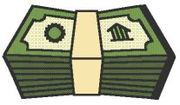1.3 Government Intervention
Government intervention refers to the ways in which a government regulates or interferes with the various activities or decisions made by individuals or organisations within its jurisdiction. The effects of this can be positive or negative for different stakeholders. In this unit we will look at the following types of government intervention: indirect taxes, subsidies and price controls.

Indirect taxes
By the end of this unit you should be able to:
By the end of this unit you should be able to:
- Explain why governments impose indirect taxes
- Distinguish between specific and ad valorem taxes.
- Draw diagrams to show specific and ad valorem taxes, and analyze their impacts on market outcomes.
- Discuss the consequences of imposing an indirect tax on the stakeholders in a market, including consumers, producers, and the government.
What different types of taxes are there? |
The effect of taxes |
|
|
|
The impact of elasticity on the consumer and producer tax burden |
Indirect Taxation - Detailed Market and Stakeholder Analysis |
|
|
|
Indirect taxes key terms

Subsidies
What we will study?
By the end of this unit you should be able to:
What we will study?
By the end of this unit you should be able to:
- Define a subsidy.
- Explain how the granting of a subsidy may affect consumers, producers, and the government.
- Explain, distingush between, illustrate and give examples of maximum and minimum price controls.
- Discuss the consequences of price controls on the stakeholders in a marlet.
How sugar subsidies ruin Halloween |
Effects of a subsidy |
|
|
|
The impact of the subsidy is to lower prices for consumers but to increase the price received by producers
Subsidies key terms
Price Controls
What we will study?
By the end of this unit you should be able to:
By the end of this unit you should be able to:
- Explain why governments impose price ceilings and describe examples of price ceilings, including food price controls and rent controls.
- Draw a diagram to show a price ceiling and analyse the impacts of a price ceiling on market outcomes.
- Examine the possible consequences of a price ceiling, including shortages, inefficient resource allocation, welfare impacts, underground parallel markets, and non-price rationing mechanisms.
- Discuss the consequences of imposing a price ceiling on the stakeholders in a market, including consumers, producers, and the government.
Crash Course Video - Good |
Food Shortages in Venezuela - Bad |
|
|
|
Visiting a supermarket in Venezuela is a challenge. “Do you have any milk?” The shop assistant shakes her head. Sugar? No. Coffee? No. Soap? No. Cornflour? No. Cooking oil? No. Do you in fact have any of the products that the government deems so essential that it fixes their prices at less than what it costs to make them? No.
Black Markets in Venezuela |
Effects of Price Controls |
|
|
|
